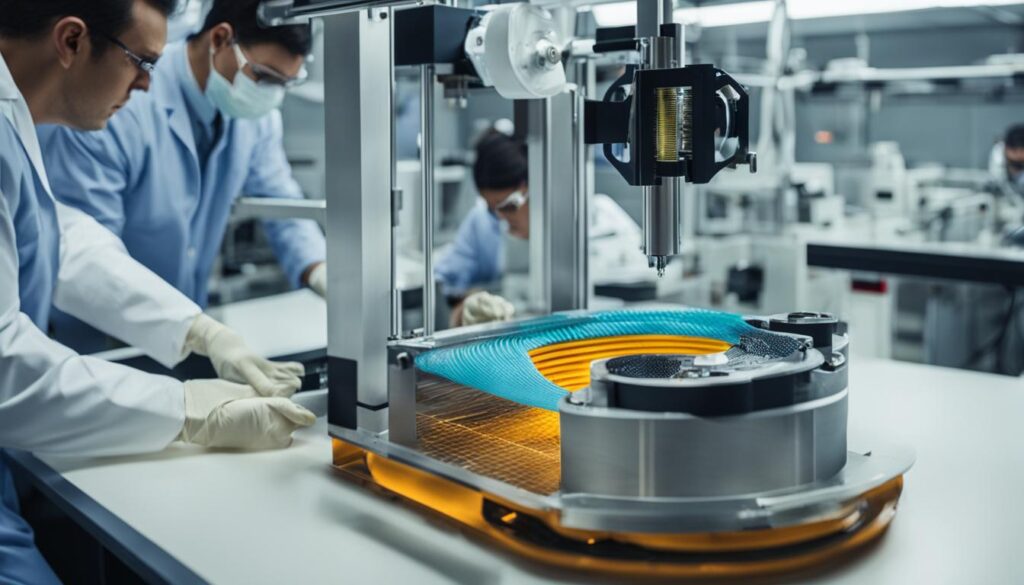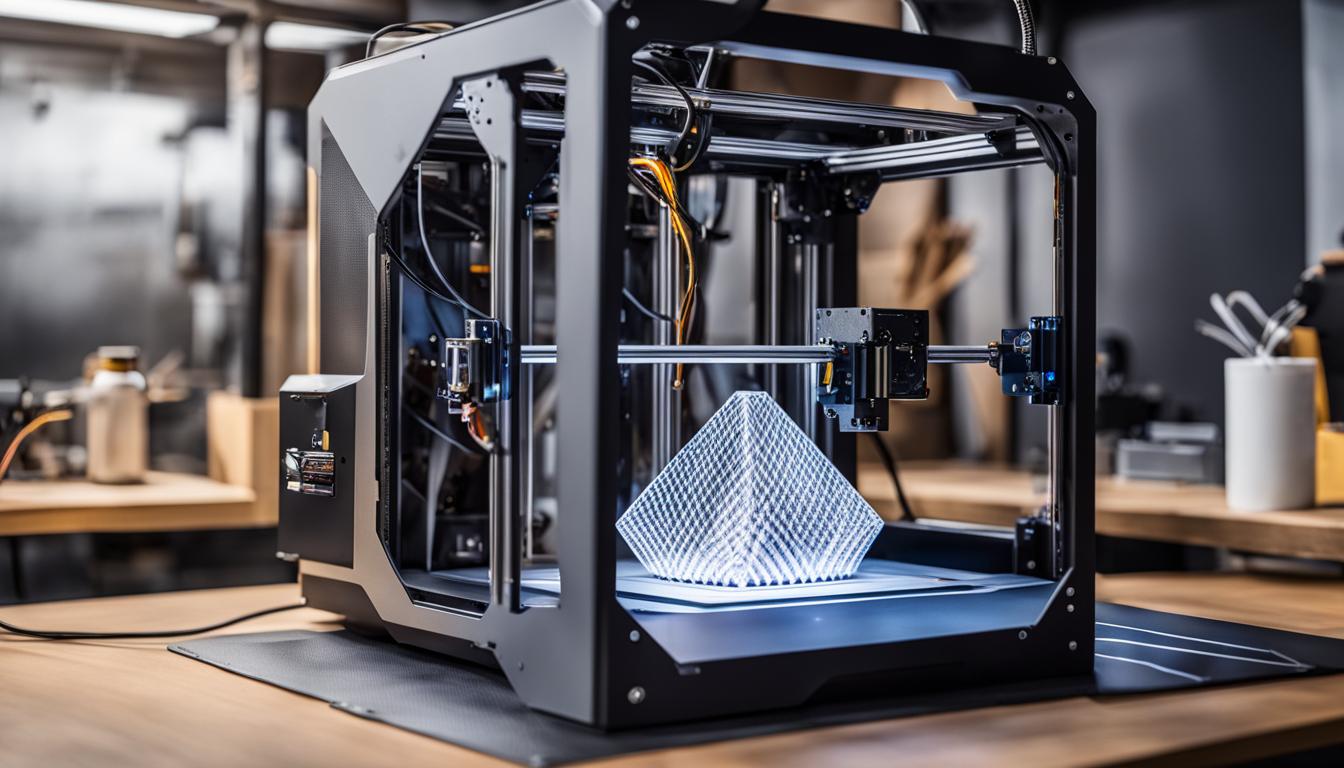Welcome to our article that delves into the world of 3D printing! If you’ve ever wondered whether 3D printers can be considered information technology, you’ve come to the right place. In this article, we’ll explore the exciting field of 3D printing technology, also known as additive manufacturing, and discuss its relevance to the realm of information technology.
Contents
Key Takeaways:
- 3D printing, or additive manufacturing, uses digital files and specialized software to create three-dimensional objects.
- It is a form of information technology due to its reliance on digital files and software for the printing process.
- There are different types of 3D printing technologies, each with its own unique process and applications.
- 3D printing offers numerous benefits, including cost savings, faster time-to-market, and customization.
- Despite its advantages, 3D printing also faces challenges such as safety concerns and material limitations.
Understanding 3D Printing
3D printing, also known as additive manufacturing, is an advanced form of manufacturing that involves creating three-dimensional objects layer by layer using digital files and specialized software. This process, often used for rapid prototyping, enables designers and engineers to quickly test and refine their designs before moving into full-scale production.
Unlike traditional manufacturing methods that involve subtracting or molding materials, 3D printing follows an additive approach. It starts with a digital model, which is sliced into thin layers. Then, layer by layer, a 3D printer deposits or solidifies material to build the final object. This additive manufacturing process offers several advantages over conventional methods, including increased design flexibility, reduced waste, and faster production times.
Rapid prototyping is one of the primary applications of 3D printing. It allows for the quick and cost-effective production of prototypes, enabling designers to assess form, fit, and function, and make design iterations without relying on expensive molds or tooling. By rapidly producing physical prototypes, 3D printing facilitates a streamlined development process and helps bring products to market faster.
One of the key advantages of 3D printing is its ability to create complex geometries and intricate designs that would be difficult or impossible to achieve with traditional manufacturing techniques. With the ability to build structures layer by layer, 3D printing unlocks new possibilities for product innovation and customization.
“3D printing has revolutionized the way we approach product development. It allows us to explore new design concepts, validate ideas faster, and iterate on designs with ease.” – John Smith, Product Designer
Moreover, 3D printing has diverse applications across industries such as aerospace, automotive, healthcare, and consumer goods. It is used for creating functional prototypes, producing custom-made parts, and even manufacturing end-use products in certain cases. This technology has transformed the manufacturing landscape, offering increased agility and efficiency.
Table: Benefits of 3D Printing
| Benefits | Description |
|---|---|
| Cost Savings | Reduces tooling costs and eliminates the need for costly molds |
| Quicker Time-to-Market | Enables rapid iteration and faster product development cycles |
| Design Flexibility | Allows complex geometries and customizable designs |
| Customization | Enables personalized products and tailored solutions |
| Reduced Waste | Uses only the necessary materials, minimizing material waste |
How Does 3D Printing Work?
There are several different types of 3D printing technologies, each with its own unique process. These include powder bed fusion, VAT photopolymerization, binder jetting, and material jetting. Let’s explore each of these processes in detail:
Powder Bed Fusion
Powder bed fusion is a 3D printing technique where thermal energy is used to selectively fuse specific areas of a powder bed. This process involves spreading a layer of powdered material and then using a heat source, such as a laser or electron beam, to melt and solidify the powder, layer by layer, based on the digital design. The melted powder fuses together to form a solid object. Powder bed fusion is commonly used in industries such as aerospace and automotive for creating strong and durable parts.
VAT Photopolymerization
VAT photopolymerization is a 3D printing process that utilizes a light source to selectively cure liquid material, typically a photosensitive resin. The technique involves a vat filled with liquid resin, and a light source, either a laser or a digital light projector, that generates a pattern to cure the resin layer by layer. As each layer is cured, it solidifies to form the desired object. VAT photopolymerization is known for its high level of detail and accuracy, making it suitable for producing intricate and complex designs, such as jewelry and dental models.
Binder Jetting
Binder jetting is a 3D printing method that involves depositing adhesive drops onto a bed of powdered material. The process starts with a thin layer of powder being spread over the build platform. Then, a print head moves across the powder bed, selectively depositing liquid binder onto the areas that need to be solidified. This binding agent acts as a glue, fusing the particles together to form the final object. Typically, binder jetting is used for creating sand molds and cores for metal casting, as well as full-color prototypes and architectural models.
Material Jetting
Material jetting is a 3D printing technique where one or more print heads deposit layers of liquid photopolymer material onto a build platform. These layers are immediately cured or solidified using UV light. Similar to inkjet printing, material jetting sprays tiny droplets of liquid material onto the build platform, building up the object layer by layer. Material jetting allows for the creation of multi-material and multi-color objects with high precision and smooth finishes. It is commonly used in industries such as product design and healthcare for creating prototypes and anatomical models.
Each of these 3D printing processes offers unique advantages and is suitable for different applications. Understanding these technologies helps us appreciate the capabilities of 3D printing and the endless possibilities it brings.
Check out the image below to visualize these 3D printing technologies in action:

3D printing technologies are transforming industries and unlocking limitless possibilities. From manufacturing to medicine, dentistry, construction, art, food, and education, this technology continues to reshape the way we design, create, and innovate.
Benefits of 3D Printing
3D printing offers a range of benefits that make it an attractive choice for various industries. From cost savings to customization, this technology has the potential to revolutionize the way we manufacture and create products. Let’s explore some of the key advantages of 3D printing:
1. Cost Savings
One of the major advantages of 3D printing is the significant cost savings it offers, particularly in the prototyping stage. Traditional manufacturing methods can be expensive, requiring expensive tooling and molds. With 3D printing, you can quickly produce prototypes at a fraction of the cost, making it an ideal solution for businesses looking to test and refine their designs.
2. Shorter Time-to-Market
In today’s fast-paced world, time-to-market is crucial for staying competitive. 3D printing allows for faster production compared to traditional manufacturing methods. The process of 3D printing eliminates the need for tooling, which can take time to produce. With 3D printing, you can iterate and refine designs quickly, reducing the time it takes to bring a product to market.
3. Customization
3D printing enables the creation of highly customizable and personalized products. With traditional manufacturing, mass production often limits customization options. However, 3D printing allows for unique designs and tailored solutions. This level of customization opens up new possibilities for industries such as healthcare, where personalized medical devices and prosthetics can be created.
4. Communication and Feedback
Effective communication and feedback are vital in product development. 3D printing simplifies this process by allowing the creation of physical prototypes that can be easily shared and reviewed. This enables stakeholders to provide valuable feedback early in the design process, facilitating collaboration and ensuring that the final product meets the desired specifications.
Overall, 3D printing offers a range of benefits, including cost savings, shorter time-to-market, customization, and improved communication and feedback. These advantages make 3D printing a game-changer in various industries, revolutionizing the way products are designed, manufactured, and brought to market.
Challenges Facing 3D Printing’s Future
While 3D printing offers numerous advantages, it also presents several challenges that need to be addressed for its future development and widespread adoption. These challenges include:
- Safety and Security: As with any technological advancement, safety and security concerns arise with 3D printing. The ability to create physical objects using digital files raises questions about potential misuse and unauthorized replication of sensitive or dangerous items.
- Quality Standards: Ensuring consistent quality standards in 3D printing is essential for reliable and accurate production. Establishing industry-specific guidelines and regulations can help maintain high-quality outputs and build trust in the technology.
- Material Limitations: The availability of suitable materials for specific 3D printing applications is an ongoing challenge. Although the range of printable materials continues to expand, there are still limitations in terms of strength, durability, and compatibility with different printing technologies.
- Intellectual Property: The ease of reproducing physical objects using digital files introduces complexities in protecting intellectual property rights. Designers and creators need effective mechanisms to safeguard their innovative ideas and prevent unauthorized replication.
It is crucial to address these challenges to ensure the safe, secure, and ethical use of 3D printing technology. By implementing robust safety measures, establishing quality standards, expanding material options, and developing intellectual property protection frameworks, we can pave the way for a future where 3D printing thrives and benefits various industries.

In addition to these technical advancements, the future of 3D printing will witness the emergence of new applications and industries. As the technology becomes more accessible and affordable, we can expect its integration into fields such as fashion, construction, and even space exploration. The versatility and adaptability of 3D printing make it an invaluable tool for pushing the boundaries of what is currently possible.
Continued research and development will be the driving force behind the growth and adoption of 3D printing. With collaborative efforts from academia, industry leaders, and passionate enthusiasts, we can anticipate breakthroughs that will revolutionize manufacturing, medicine, design, art, and more.
The Innovations in 3D Printing
The future of 3D printing also holds tremendous potential for game-changing innovations. Here are some exciting developments that we may witness:
- Multi-material Printing: New technologies are being developed to enable the simultaneous printing of multiple materials, opening up opportunities for complex and functional designs.
- Nanotechnology Integration: Researchers are exploring ways to integrate nanotechnology into 3D printing, allowing for the creation of materials and structures with enhanced properties and capabilities.
- Bioprinting and Tissue Engineering: The field of bioprinting aims to print living tissues and organs, offering the potential for personalized medical treatments and reducing the organ transplant waiting list.
- Large-Scale 3D Printing: Advancements in construction 3D printing will allow for the creation of entire buildings using additive manufacturing techniques, revolutionizing the construction industry.
As these innovations become a reality, the impact of 3D printing will extend even further, transforming industries, creating new business opportunities, and improving the quality of life for individuals worldwide.
Conclusion
In conclusion, 3D printers are an essential part of the information technology landscape. By utilizing digital files and specialized software, they enable the process of additive manufacturing, also known as 3D printing. This innovative technology has diverse applications across various industries and offers a multitude of benefits.
One of the key advantages of 3D printing is its cost-saving potential. The ability to create prototypes and small-scale production runs with reduced expenses compared to traditional manufacturing methods makes it an attractive option for businesses. Additionally, 3D printing offers a faster time-to-market, allowing companies to quickly iterate and refine their designs.
Another significant advantage of 3D printing is customization. This technology empowers designers and manufacturers to create unique, tailored solutions to meet specific needs and requirements. It also enhances communication and feedback processes, as physical prototypes can be easily shared and reviewed.
While there are challenges to overcome, such as safety concerns and material limitations, the future of 3D printing appears promising. Ongoing advancements and innovations will continue to drive its growth and integration into various industries, revolutionizing the way we manufacture and create physical objects.
FAQ
Are 3D printers considered information technology?
Yes, 3D printers are considered a form of information technology as they utilize digital files and software to create physical objects through the process of additive manufacturing or 3D printing.
What is 3D printing?
3D printing, also known as additive manufacturing, is the process of creating three-dimensional objects layer by layer using digital files and specialized software. It is often used for rapid prototyping and offers numerous benefits over traditional manufacturing methods.
How does 3D printing work?
There are several different types of 3D printing technologies, including powder bed fusion, VAT photopolymerization, binder jetting, and material jetting. Each technology has its own unique process, but all involve the sequential layering of materials to build the object.
What are the applications of 3D printing?
3D printing has a wide range of applications across various industries. It is used in manufacturing for prototyping and small-scale production. In the medical field, it is used for creating customized implants and prosthetics. Dentists use 3D printing for custom-designed teeth and dental appliances. The construction industry is exploring the use of 3D printing for building homes and structures. Artists use it to create unique sculptures. Even the food industry is starting to utilize 3D printing for creating edible products. Additionally, 3D printing is used in education for hands-on learning and visual aids.
What are the benefits of 3D printing?
3D printing offers several advantages, including cost savings, shorter time-to-market, customization, and improved communication and feedback. It is cost-effective for prototyping, as traditional methods can be expensive. The process is faster than traditional manufacturing methods, allowing for quicker product development. The ability to customize and personalize products is another advantage, as 3D printing allows for unique designs and tailored solutions. Additionally, the physical prototypes can be easily shared and reviewed, facilitating better communication and feedback.
What challenges does 3D printing face?
3D printing faces challenges related to safety, security, quality standards, material limitations, and intellectual property. Ensuring safety and security is important to prevent misuse of the technology. Meeting quality standards and regulatory requirements is crucial for widespread adoption. Material limitations, such as the availability of suitable materials for specific applications, can pose challenges. Protecting intellectual property rights becomes more complex in a world where anyone can create physical objects using digital files.
What does the future of 3D printing hold?
The future of 3D printing holds great potential for further technological advancements and innovations. It is expected that there will be improvements in speed, resolution, and material capabilities. New applications and industries will emerge, pushing the boundaries of what is possible with 3D printing. Continued research and development will drive the growth and adoption of this technology in the years to come.




